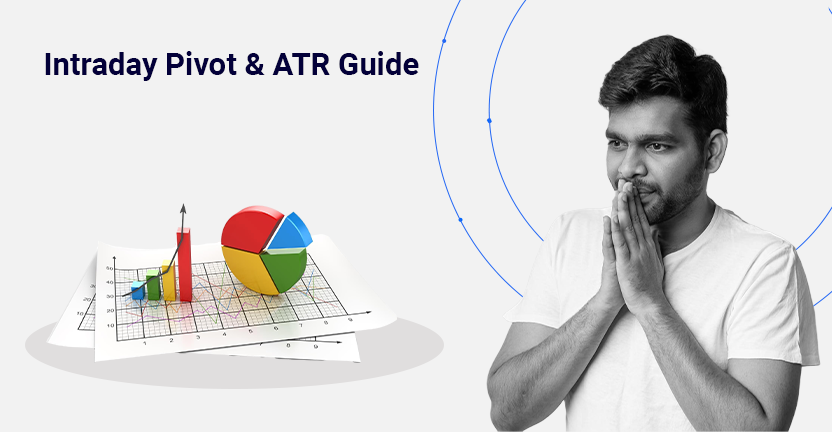Intraday trading is no easy feat. It requires vigilance, quick decision-making, and the ability to interpret real-time data. Enter pivot points and the Average True Range (ATR) – essential tools helping day traders make informed decisions by identifying critical price levels and market volatility.
This guide will explain how pivot points and ATR can be used together for more strategic and confident intraday trades.
What Are Pivot Points, and Why Do They Matter?
Pivot points are technical analysis calculations used to determine the trading day’s potential support and resistance levels. They help traders anticipate price movements based on the previous session’s high, low, and close prices. For intraday traders who thrive on short-term price action, pivot points provide key indicators for deciding entry and exit positions.
Key Points About Pivot Points:
- Bullish Bias: If the stock trades above the pivot point level, it signals bullish sentiment.
- Bearish Bias: When trading below the pivot point, bearish sentiment dominates.
- Static Levels: Unlike other indicators, pivot points remain constant throughout the day, making them reliable for intraday strategies.
Pivot levels include:
- Primary Pivot Point (PP): The central reference level.
- Resistance Levels (R1, R2, R3): Predicted price ceilings.
- Support Levels (S1, S2, S3): Predicted price floors.
Why Should Intraday Traders Use Pivot Points?
Pivot points are particularly effective for day traders due to their simplicity and applicability in fast-moving markets. Traders rely on pivot levels to:
- Identify key price zones.
- Set precise entry/exit points.
- Define stop-loss and profit-target orders.
For instance, if a stock bounces off S1 (support 1), it may signal an ideal point for a long trade. Similarly, a breakout above R2 could indicate strong bullish momentum, presenting a good opportunity for a quick profit.
What Is ATR, and How Does It Complement Pivot Points?
While pivot points provide static price levels, the Average True Range (ATR) measures market volatility, showing how much an asset typically moves within a given day. Using ATR alongside pivot points equips traders with additional context to determine the likelihood of price levels being achieved.
ATR’s Role in Intraday Trading:
- Volatility Measure: A higher ATR indicates more significant price movement during the trading day, while a lower ATR suggests less volatility.
- Stop Loss Positioning: ATR helps traders set stop-loss levels based on the asset’s typical price fluctuations. For instance, a stop loss set too close to a volatile stock risks being triggered prematurely.
- Trade Timing: ATR allows traders to adjust their strategies depending on market conditions. For instance, during periods of low volatility, traders may opt for scalping strategies instead of breakout trades.
Together, pivot points and ATR form a powerful combination for day traders. While pivot points define key price levels, ATR ensures traders remain cognizant of market volatility to avoid false breakouts or poorly placed stop orders.
6 Steps to Use Pivot Points and ATR for Intraday Trading
Follow these steps to effectively combine pivot points and ATR for strategic intraday trades.
1. Calculate Pivot Points
Start by calculating the primary pivot point (PP), resistance levels (R1, R2, R3), and support levels (S1, S2, S3): PP = (Previous High + Previous Low + Previous Close) ÷ 3
Resistance and support levels are derived using this formula:
- R1 = (2xPP)-Low
- S1 = (2xPP) – High
- R2 = (PP – S1)+R1
- S2 = PP – (R1 – S1)
- R3 = (PP – S2) + R2
- S3 = PP – (R2 – S2)
Most modern trading platforms have built-in tools to automatically calculate and display pivot points on charts, eliminating the need for manual calculations.
2. Overlay ATR on Your Chart
Add the ATR indicator on your trading platform to assess the day’s market volatility. Keep in mind the following:
- A high ATR value signals intense market volatility, creating lucrative opportunities for breakout or trend-following strategies.
- A low ATR value signifies reduced price movement, suggesting range-bound or scalping strategies may yield better results.
3. Use Pivot Points to Identify Key Levels
Analyse the pivot levels to identify the following:
- Entry Points: For example:
- Buy near S1 if the price bounces.
- Sell near R1 if the price tests resistance and reverses.
- Exit Points or profit booking zones dictated by R2 or S2 levels.
4. Assess Price Action with ATR
ATR helps determine whether pivot points are likely to hold or break:
- High ATR Scenario (high volatility): Breakouts beyond R1 or S1 are more probable, suggesting you may wait for a price confirmation before entering.
- Low ATR Scenario (low volatility): Pivot levels like PP, R1, and S1 are more likely to hold. Use these as zones for bounce trades.
5. Set Stop-Loss and Targets
Position stop-loss orders based on both pivot levels and ATR values. For example:
- High ATR values warrant placing your stop-loss order farther from the entry point to avoid getting stopped during normal market fluctuations.
- Tighter stop-loss levels can be considered during low ATR periods since price movement is minor.
6. Combine with Other Indicators
Pivot points and ATR strengthen your trading decision when used with other indicators like:
- Moving Averages for trend confirmation.
- RSI (Relative Strength Index) for overbought/oversold signals.
- Candlestick Patterns to validate bounce or breakout signals.
For example, if a strong bullish candlestick pattern forms at S1. At the same time, ATR confirms high volatility, which might indicate a substantial buying opportunity.
Practical Intraday Trading Example
Imagine a stock’s pivot point values are:
- PP = 100
- R1 = 104
- R2 = 108
- S1 = 96
- S2 = 92
The ATR is relatively high at 5 points, indicating intense intraday volatility.
- Scenario 1 (Bounce Trade): The stock hits S1 at 96 and forms an upward bounce with a bullish candlestick pattern. Enter a long trade at 96, with a stop loss at 94 (ATR-based support for volatility) and a target near PP (100).
- Scenario 2 (Breakout Trade): Later, the price breaches R1 at 104 during high trading volume. Enter a long trade near 105 with a stop loss at 103 and target R2 (108).
Benefits of Using Pivot Points and ATR Together
By combining pivot points (fixed price levels) and ATR (volatility-driven context), you unlock several advantages in intraday trading:
- Improved Trade Precision: A clearer understanding of entry, exit, and stop-loss points.
- Risk Mitigation: ATR-based stop-loss placements reduce the likelihood of premature exits.
- Adaptability: Tailor strategies to match market volatility in real-time, reducing unnecessary risks.
Master Intraday Trading: Your Road Ahead
Understanding tools like pivot points and ATR is essential for any day trader. These tools enable more structured, informed trading decisions while minimising impulsive risk-taking.
Streetgains simplifies intraday trading by offering well-researched insights tailored to market conditions. With a credits-based subscription model, traders can access risk-managed trade calls designed to align with their financial goals.
Disclaimer:
The content in this blog is intended for informational purposes only and does not constitute investment advice, stock recommendations, or trade calls by Streetgains. The securities and examples mentioned are purely for illustration and are not recommendatory.
Investments in the securities market are subject to market risks. Please read all related documents carefully before investing.
How to Use Pivot Points and ATR for Intraday Trading? FAQs:
Pivot points are calculated based on the prices of the previous day. In contrast, support and resistance levels are identified using technical analysis techniques like trend lines or moving averages.
Yes, you can apply these tools to swing trades as well. However, your stop-loss orders must likely be adjusted to account for more extended holding periods.
ATR can be used with other technical indicators such as moving averages, RSI, or Bollinger Bands to validate trading signals and increase the probability of a successful outcome.
No, most trading platforms have built-in tools that automatically calculate pivot points for you. This eliminates the need for manual calculations and streamlines the decision-making process.
Yes, some traders use multiple types of pivot points (e.g., Fibonacci, DeMark) in conjunction with traditional pivot points to create more comprehensive support and resistance levels.
Some common mistakes include placing stop-loss orders too close or too far from entry points, not considering market volatility when setting targets, and not combining these tools with other indicators for confirmation.
Yes, pivot points and ATR can be applied to cryptocurrency trading similarly to any other asset class. However, it’s essential to consider the unique volatility of cryptocurrencies when setting stop-loss orders and profit targets.
Streetgains provides meaningful trade calls and insights tailored to various market scenarios. You can access informed setups seamlessly by leveraging our subscriptions and incorporating tools like pivot points and ATR. This enables more precise entries, exits, and risk management, helping you trade confidently and effectively.
FAQs:
-
1. How to earn money daily from trading?
Earning money daily from trading involves strategies like day trading, where traders capitalise on small price movements within the same day. Success requires real-time market analysis, quick decision-making, and risk management.
-
2. How to earn money from equity trading?
To earn money from equity trading, you need to buy stocks at a lower price and sell them at a higher price. Success depends on researching companies, analysing stock trends, and using technical or fundamental analysis.
-
3. How to earn money from share trading in India?
In India, share trading offers profit potential through buying and selling stocks on exchanges like the NSE and BSE. To maximise returns, traders should use market research, tools like technical analysis, and risk management strategies.
-
4. How to make money from share trading in India?
Making money from share trading involves selecting the right stocks, timing the market, and implementing trading strategies like swing trading or day trading while staying informed about market trends.
-
5. How to transfer money from a trading account to a bank account?
To transfer money from your trading account to your bank, log into your trading platform, navigate to the funds section, and initiate a withdrawal request. The money will typically be credited to your linked bank account in 1 to 3 days.
-
6. How to withdraw money from a trading account?
You can withdraw funds by logging into your trading account, selecting the withdrawal option, and selecting the amount to transfer to your bank account. Ensure your bank account is linked and follow any steps your broker requires.
Subscribe to our Credits-Based Research System:
Pay only for successful research calls!












